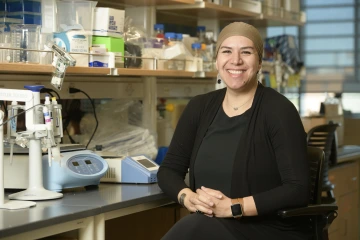Compound Developed at UArizona Health Sciences Provides Innovative Pain Relief
Findings position startup Regulonix for next steps in commercialization

Rajesh Khanna, Ph.D.
Photo courtesy of University of Arizona Health Sciences
Updated November 11, 2021, 10:00 AM
Tucson, ARIZ. – Researchers at the University of Arizona College of Medicine – Tucson and the BIO5 Institute have made a significant breakthrough on a safe and effective non-opioid pain reliever. The team includes Rajesh Khanna, professor of pharmacology; May Khanna, associate professor of pharmacology; and Vijay Gokhale, associate research professor. The prestigious medical journal, Science Transitional Medicine, published the results of this breakthrough study in its November 2021 issue.

May Khanna, Ph.D.
Photo courtesy of University of Arizona Health Sciences
The results published demonstrate that the compound – dubbed “Compound 194” – provides non-addictive pain relief on its own. The team observed a synergistic effect when 194 was combined with morphine or gabapentin. This is a promising sign that 194 could also be used in a dose-reduction strategy for painkillers that have negative side effects, including opioids, while maintaining high levels of pain relief.
With the help of Tech Launch Arizona, the office of the UArizona that commercializes inventions stemming from research, the university patented the compound and licensed it to startup Regulonix LLC, founded by the Khannas and Gokhale to bring the innovation to the world.
“The publication of these results represents a huge proof point for our research and positions Regulonix for our next big leap forward,” said Raj Khanna. “We launched the company with this moment in mind, and we’re excited to have this validation and move ahead.”
“Having worked with the team for a number of years to advance this research toward market readiness, we’re thrilled for this news and the implications for the startup,” said Doug Hockstad, assistant vice president of TLA. “In light of the nation’s opioid addiction crisis, the potential impact is monumental.”
“This is a breakthrough in the management of opioid use and, moreover, abuse. If the human data follows the results in small animals, morphine and similar drugs could be rendered virtually harmless, while maintaining the pain relief attributes of the original drug”, said Flecther J. McCusker, CEO and Founder of UAVenture Capital, the Tucson based risk capital firm that funded the company.
The World Health Organization (WHO) has called opioid addiction a global epidemic. The number of opioid overdoses has increased in recent years in several countries, in part due to the increased use of opioids for the management of chronic pain. In the United States of America, the number of people dying from opioid overdose increased by 120% between 2010 and 2018, and two-thirds of opioid-related overdose deaths in 2018 in the U.S. involved synthetic opioids, including fentanyl and its analogues. During the COVID-19 pandemic, a substantial increase in drug-related overdose deaths was reported, primarily driven by rapid increases involving synthetic opioids. In 2020, an estimated 10.1 million US citizens aged 12 or older misused opioids.
The initial studies done by Khanna and their team were funded by National Institutes of Health grants CA210857 from the National Cancer Institute and DA042852 from the National Institute on Drug Abuse. Additional funding to advance the technology was provided by Tech Launch Arizona through its Asset Development Program.
Understand the Background
If you'd like to understand more of the scientific foundations of this innovation, read this story on the University of Arizona Health Sciences Website.
Compound Developed at UArizona Health Sciences Provides Innovative Pain Relief, November 10, 2021
Read the Abstract
Want to dig into the details? Read the abstract of the published research, Selective targeting of NaV1.7 via inhibition of the CRMP2-Ubc9 interaction reduces pain in rodents, on the Science.org website.

